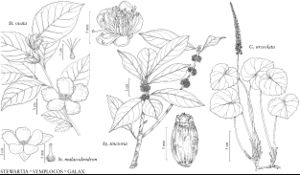Difference between revisions of "Symplocos"
Enum. Syst. Pl., 5, 24. 1760 ,.
FNA>Volume Importer |
imported>Volume Importer |
||
| (5 intermediate revisions by 2 users not shown) | |||
| Line 46: | Line 46: | ||
-->{{#Taxon: | -->{{#Taxon: | ||
name=Symplocos | name=Symplocos | ||
| − | |||
|authority=Jacquin | |authority=Jacquin | ||
|rank=genus | |rank=genus | ||
| Line 58: | Line 57: | ||
|publication year= | |publication year= | ||
|special status= | |special status= | ||
| − | |source xml=https:// | + | |source xml=https://bitbucket.org/aafc-mbb/fna-data-curation/src/2e0870ddd59836b60bcf96646a41e87ea5a5943a/coarse_grained_fna_xml/V8/V8_653.xml |
|genus=Symplocos | |genus=Symplocos | ||
}}<!-- | }}<!-- | ||
-->[[Category:Treatment]][[Category:Symplocaceae]] | -->[[Category:Treatment]][[Category:Symplocaceae]] | ||
Latest revision as of 22:45, 5 November 2020
Shrubs or trees, glabrous or hairy (hairs simple, 1-celled, with transverse septa); new vegetative growth from axillary and/or pseudoterminal buds. Branches smooth at maturity, glabrous or white- or rufous-pubescent. Leaves often sweet tasting; blade with marginal teeth usually glandular, apex acute to acuminate, midvein abaxially prominent, adaxially raised, prominent, or impressed [rarely flat]. Flowers fragrant; sepals imbricate; petals imbricate, white or yellow [pink, reddish, or lavender]; filaments glabrous [hairy]; anthers rotund-ovate to spheric. Drupes usually blue, sometimes orange to brown [white], crowned by persistent calyx; endocarp 1[–5]-celled. x = 11.
Distribution
e, s United States, West Indies (Antilles), South America (Argentina, Brazil), Asia (China, India, Japan), Pacific Islands (Fiji), Australia, temperate, tropical, and subtropical areas.
Discussion
Species 318 (2 in the flora).
1 Leaf midveins impressed adaxially, blade margins closely serrate, serrulate, or dentate; inflorescences paniculate, usually internodal; flowers appearing with leaves; corolla lobes
2.5–5 mm; styles 2–4 mm; drupes bright blue to bluish black 1. Symplocos paniculata
Selected References
None.
Lower Taxa
Key
| 1 | Leaf midveins impressed adaxially, blade margins closely serrate, serrulate, or dentate; inflorescences paniculate, usually internodal; flowers appearing with leaves; corolla lobes 2.5-5 mm; styles 2-4 mm; drupes bright blue to bluish black. | Symplocos paniculata |
| 1 | Leaf midveins raised to prominent adaxially, blade margins usually obscurely crenulate-serrulate, teeth remote, sometimes nearly entire; inflorescences fasciculate, axillary; flowers appearing before leaves; corolla lobes 6-8 mm; styles 5-6 mm; drupes dark orange to brown. | Symplocos tinctoria |
